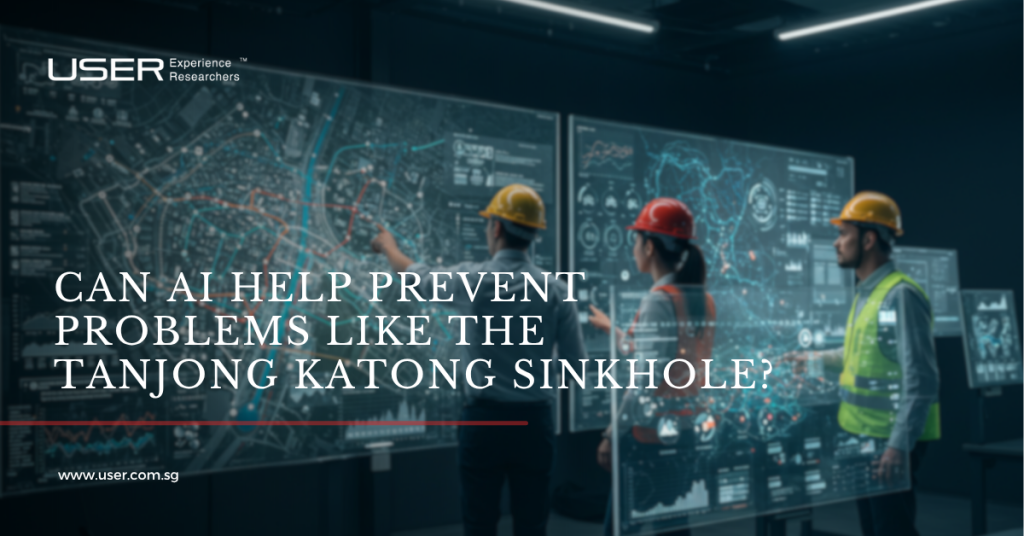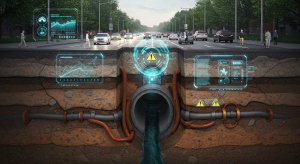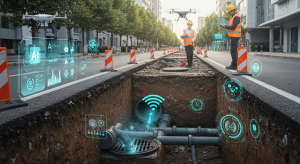
AI as A Planning and Monitoring Tool?
On 26 July at around 5PM, a sinkhole suddenly opened beside a sewer construction site at Tanjong Katong Road, swallowing a car and injuring its driver, disrupting traffic, water services to some households in the area, and causing a wave of worry to form online. Thankfully, no lives were lost in the incident, but it exposed how vulnerable public infrastructure can be, even if preventive measures have been applied. According to some experts, construction in the area may have contributed to the formation of the sinkhole. As of writing, there are no official statements yet as to what caused the sinkhole to form.
The incident sparked conversations about monitoring and maintenance of roads and the big question: “Could this have been prevented?”
Technological developments and constantly updating safety standards have empowered governments and public safety agencies around the world. In the age of artificial intelligence and real-time monitoring, what tools do we need to help prevent similar incidents in the future?
To understand how AI can support safer infrastructure, we first need to look at the challenges faced by public works today.
The Hidden Challenges in Public Works

Public works often face silent threats. Underground erosion, ageing pipes and shifting soil can all lead to sudden failures. Traditional inspections also present only limited results, relying on human observation and are often reactive. Problems are usually spotted only after signs like cracks or leaks appear.
According to Associate Professor Wu Wei from the Nanyang Technological University, “Sinkholes cannot form suddenly. They need time for the surrounding soil to wash away, causing the cavity to get larger.”
There are many tools and preventive measures used to prevent design- or construction-related deformation of soil, from the planning stage to construction. Onsite, ground-penetrating radars can be used during periodic inspections to assess the ground. However, there are limitations to this also, as Assoc. Prof. Wu also said, that these can only check to depths of 5m and may be less effective when water is present, which can be a contributing factor to the Tanjong Katong incident too, since nearby sewerage works are ongoing in the area.
While Singapore is one of the world’s most safety-centric places when it comes to executing public works, there is always something to improve on. However, some factors may still elude engineers, which may prompt the need for more real-time-enabled monitoring and analysis.
This is where artificial intelligence can make a real difference.
Turning Data into Prevention
Today, Generative AI (GenAI) is utilised in many cases that involve simulations and monitoring, which is why it has made its way to almost every area of business and government. Carefully constructed AI learning models can “study” past data such as weather patterns, soil behaviour and construction history to predict where problems might occur. For example, if a sewer shaft shows signs similar to a previously recorded collapse elsewhere, AI can raise the alarm before it is too late.
AI simulations can also allow engineers to test materials and designs in virtual environments. With these digital sandboxes, they can see how a structure might respond to stress, moisture or even extreme weather. In the case of road works, it can help designers and engineers assess possible sinkhole formation. This helps teams make smarter decisions before construction begins.
Another way is to use AI in real-time monitoring of construction works. By using Internet of Things (IoT) sensors in combination with field tools, engineers can monitor things like ground movement, moisture levels and pressure changes in real time. These sensors act like a nervous system, constantly feeding data to AI systems that can detect early warning signs. Using AI this way can be incredibly helpful to study potential changes in the environment after development to prevent possible unwanted deformations in the future, or in ensuring everything goes according to plan in new sites.
With a foundation in usage the above in place, AI can go even further helping not only detect problems in public works but also predict and prevent them instead of waiting for something to go wrong. Combined with cumulative expertise from industry players, AI in public works can shift infrastructure planning from reactive to proactive.
This shift in mindset opens the door to a more thoughtful and strategic approach to innovation.
Planning for a Safer Tomorrow
The future of infrastructure safety lies in foresight and AI is the best tool to help get us there. It allows us to move beyond the current reach of our safety measures to better anticipate and mitigate risks, collect useful data and understand patterns, and make informed decisions to prevent problems from rising. From monitoring unseen shifts in soil to simulating construction outcomes, AI offers practical yet advanced ways to strengthen the systems we rely on every day.
But technology alone is not enough. It must be guided by insight, shaped by experience and designed with people in mind. That is where thoughtful collaboration becomes essential. Government agencies, private contractors, and scientific communities should participate in bettering safety evaluation and continuous improvement in executing construction projects by updating their tools and strategies in ensuring that public infrastructure is delivered not only on time, but to create a sense of security for the people who will use them.
About USER Experience Researchers Pte. Ltd.
USER is a leading UX-focused company specialising in digital transformation consultancy, enterprise solutions, and workforce solutions. We have a steadfast commitment to innovating the best of today’s technology to promote sustainable growth for businesses and industries.



